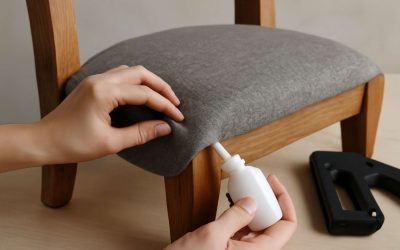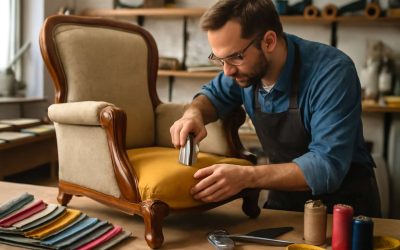When reupholstering an armchair it’s essential to make sure you have all the right materials to complete the job. This will include the main fabric, a staple gun and tack strips and if the chair has piping you will also need welting. The other important items are poly fibre filling or stuffing and quilt batting. These can be bought online or at fabric stores, or at a craft store. You will also need a rotary cutter, scissors, needle-nose pliers and an iron. Depending on the style of your chair you may need additional materials such as cardboard tack strips and metal tack strips, trim and furniture glue, fabric glue, or wood filler.
Before you start removing any of the old fabric, take lots of photos from different angles. This will help you remember how your chair is put together when it comes time to reassemble it. It’s also a good idea to label everything you remove (sticky labels are a good choice) and keep a note of what goes where on the chair so that when you put it back together you can be sure to get things in the same place they were before.
The first step is to remove the legs from the chair, if there are any. Some legs will be screwed to the frame, others will be nailed on. If you’re not comfortable using a drill or flathead screwdriver, you can call a professional to come and do it for you.
Once the legs are removed, it’s a good idea to paint or re-stain them before you reattach them to the frame. This will protect them from water damage and prevent them from becoming scuffed or scratched as you move the chair around.
Now you can start removing the existing fabric from the chair. As you do this, be careful not to ruin the existing structure of the chair by pulling out screws or nails. Generally, it’s best to remove the fabric from one side of the chair at a time, starting at the bottom and working your way up. It’s also a good idea not to pull out any of the tacks or staples until you are sure you have enough fabric to cover them.
Once all of the old fabric is removed, it’s time to clean the chair. Use a damp cloth to wipe it down and then use a dry brush to remove any dust and debris. If there are any loose threads, they can be trimmed with a sharp pair of scissors. If there are any holes or tears in the seat, now is the time to repair them, and add some extra padding for comfort. Now is also a good time to sand down any rough edges on the frame of the chair. Finally, spray on some polyurethane to protect the new fabric.



0 Comments